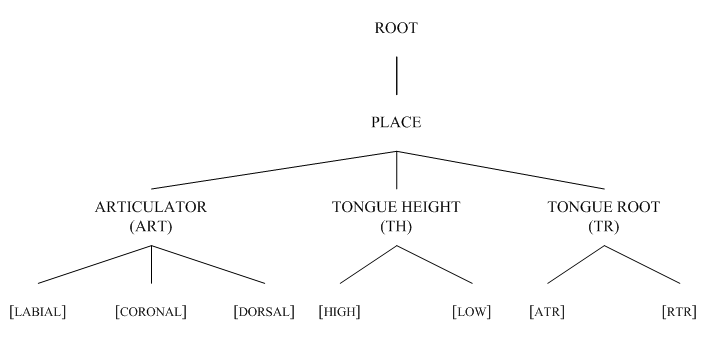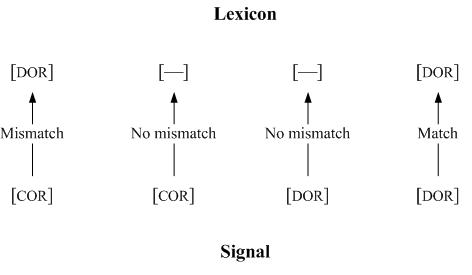Project description
The assumptions of the Featurally Underspecified Lexicon, which are crucial for this project, are the following (see also Lahiri & Reetz, 2002):
- Speech sounds in the mental lexicon are sets of phonological features with a specific geometry (based on Clements, 1985)

- In this geometry, PLACE dominates the nodes ARTICULATORS and TONGUE HEIGHT; i.e., DORSAL does not dominate HIGH and LOW
- Speech sounds are not necessarily specified for every conceivable features
- CORONAL is always underspecified in the mental lexicon
- Tongue Height features are crucial for palatalization and retroflexion
- A three-way matching algorithm (match, mismatch, nomismatch) governs mapping of features extracted from the speech signal to the phonological features in the mental lexicon:
- A full match and subsequent activation of the corresponding lexical representation is achieved if features from the signal find their equivalent features in the mental lexicon, whereas a
- nomismatch occurs when features from the speech signal do not mismatch with the lexical representation.
- A mismatch occurs, when extracted features conflict with features in the lexicon; e.g., [CORONAL] from the signal mismatches [DORSAL] in the lexicon.

Featural representations of phonemes
Phonological analyses in FUL claim that the place features CORONAL and DORSAL for both vowels and consonants are mutually exclusive. An MEG study with natural German stimuli showed that German vowels, CORONAL /ü ö/ and DORSAL /u o/, activated distinct areas in the auditory cortex, irrespective of other features such as tongue height or lip rounding. This was replicated using CV-syllables and pseudowords. The fact that these differences covaried with more general feature categories across phoneme boundaries suggests that the processing of speech around 100 ms post stimulus onset is influenced by abstract phonological features rather than by phoneme category.
A recent functional magnetic resonance imaging (fMRI) study using the same vowel material as study also showed that place features CORONAL and DORSAL play a dominant role: it is these features’ topographical representation in the auditory association cortex that appeared partly segregated.
FUL assumes that CORONAL is underspecified in the mental lexicon – this has been shown earlier with assimilated consonants (Lahiri & Reetz 2002).
Mismatch Negativity (MMN), an automatic change detection response in the brain which is sensitive to language-specific phoneme representations, was used to examine these representational hypotheses. Using natural vowel pairs we found significant asymmetric latency differences in the MMN for German /e, ö/ (underspecified for [CORONAL]) versus /o/ (specified for [DORSAL]). When the incoming speech sound was CORONAL, the MMN latency was modulated by the featural representation of the previous stimulus. The latency was earlier when the place representation was DORSAL, and delayed when it was CORONAL. No latency differences were found when the incoming speech sound was DORSAL. This provides the first neurobiological evidence for a featurally underspecified mental representation.
Very recently, neurolinguistic experiments in other labs also confirm the asymmetry in representation (e.g. Walter & Hacquard 2004).
With the same MMN design, we examined the representation of phonological height. We asked if acoustically identical vowels would exhibit different patterns when the phonological systems differ. On the basis of phonological alternations, we claim that [o] in German is underspecified for height while it is specified as [LOW] in Bengali. In comparison with /u/, which is specified as [HIGH] in both languages, [o] would mismatch with /u/ in Bengali but not in German. Again, EEG studies showed asymmetric latency differences to identical stimuli, corroborating the asymmetry in phonological representations.
FUL also assumes that CORONAL remains underspecified even if there are two coronal consonants, such as dental and retroflex stops in Bengali. Based on historical data we hypothesised that the stops are both unspecified for place, but are distinguished by height, retroflex being [HIGH]. Alternative phonological analyses assume that POSTERIOR, a sub-node feature of CORONAL, distinguishes retroflexes from dentals, and hence CORONAL itself must be specified (cf. Hall 1997). Indirect semantic priming shows that this is not the case. Instead, both dentals and retroflexes fail to activate words with labials and dorsals (since the feature CORONAL mismatches DORSAL or LABIAL), but not the other way around (DORSAL and LABIAL do not mismatch unspecified PLACE) validating the hypothesis that coronality in these consonants is underspecified.
Lexical representations of monomorphemic words
According to FUL, features extracted from the signal activate all word candidates beginning with these features (as in the earlier cohort theory based on phonemes), and deactivate all words which mismatch even in one feature. Another aspect of FUL’s lexical representational hypothesis is the fact that together with its phonological form the meaning of a word is simultaneously activated. Thus, short words should activate longer words (Fell 'fur' activates Feld 'field') along with their meaning (Acker 'acre'). But a short word would be deactivated (phonological form and meaning) once a longer word is heard. Thus, Feld does not activate Fell, nor the semantically related word Pelz 'fur'). These predictions were confirmed in indirect semantic priming experiments in German as well as in Bengali. Testing similar hypotheses in neurophysiological experiments using event-related brain potentials (ERPs), we used pseudoword priming to examine the idea that nomismatching words would remain activated. The hypothesis was that pseudowords beginning with CORONAL features (e.g., *Drenze) would mismatch with a real word which differed only in the first consonant which was LABIAL or DORSAL(Grenze 'border'), and would not be activated. In contrast, the pseudoword *Brachen with an initial LABIAL would activate Drachen ('dragon'), represented with an initial underspecified consonant. In a lexical decision task, pseudoword targets diverged from words only in the place of articulation of the initial consonant. We found larger P350 responses in the ERPs for coronal pseudowords (e.g., *Drenze) diverging from noncoronal words (e.g., Grenze) than for noncoronal pseudowords (e.g., *Brachen) diverging from coronal words (e.g., Drachen). Thus, an initial CORONAL stop can be activated by all strings that diverge in the initial place of articulation (LABIAL or DORSAL), but words with a non-coronal place of articulation, which is represented in the lexicon, cannot be activated if a CORONAL place of articulation is extracted from the acoustic signal. In a second experiment we further examined the neurophysiological validity of underspecification with fragment priming. Earlier research has shown that fragments can activate longer words which have complete initial overlap (Marslen-Wilson & Zwitserlood 1989). ERPs revealed that pseudoword onsets with non-coronal place of articulation activated coronal words (e.g., in the prime-target pair *brach-Drachen). In contrast, we did not find ERP priming effects for noncoronal words preceded by coronal pseudoword onsets (e.g., *dren-Grenze). The results are discussed as direct evidence for a featurally underspecified lexicon.
Featural representation in morphophonological alternations
FUL assumes that phonological alternations like vowel-raising in 2/3P SG of strong verbs (schl[a]fe1P~schl[E:]fst2P ) are derived from single underspecified phonological representations of the root morpheme where the root vowel is only specified as [LOW]. In contrast, the vowels of weak verb roots which show no such alternation – m[a]che1P~m[a]chst2P – are represented with [DORSAL, LOW]. On the other hand, general phonological principles determine that strong roots as well as weak roots contain /e/ as underspecified for place. (g[e]be1P ~g[i]bst2P b[e]lle1P ~b[e]lst2P), since both [i] and [e] are coronal vowels. Several priming studies, delayed as well as immediate, showed that both strong and weak infinitives could be primed equally well by their corresponding 2SG PRESENT forms, thereby confirming our representational hypotheses and disconfirming dual route models which postulate separate and associatively listed stems for the present tense in those paradigms (Sonnenstuhl et al.1999, Clahsen 1999). Further extending the underspecified single root hypotheses for verbs to vowel alter-nations (umlaut) in the singular~plural distinction of nouns (Stock-Stöcke vs. Stoff~Stoffe), we compared the singular forms with their respective diminutives (Stöckchen~Stöffchen). Although both diminutives have umlauted vowels, the root vowel of Stock is underspecified for place (only [LOW]) while Stoff has a [DORSAL, LOW] specification. Thus, the diminutives (which have independent representations) differ in their matching algorithms with the roots of the singulars: Stöffchen mismatches Stoff, but Stöckchen does not mismatch Stock. Using an MMN design, preliminary results of an “ERP study” show that there is a faster latency for the mismatching condition as compared to the matching condition.
Ongoing research
The essential questions remain the same: How are (morpho-)phonological variations parsed and accessed by native speakers? What is the nature of the phonological representation in the mental lexicon? What is the role of the phonological lexical representation in resolving the problem of access and recognition of morphophonological variation?
Our objectives at the end of the period are to be able to provide as comprehensive as possible a picture regarding the phonological representation of a word in the mental lexicon, if we have evidence of the featural and tonal parameters of a given language. General linguistic principles as well as language-specific theoretical linguistic evidence and experimental evidence (behavioral and neurobiological data) should assist us in determining language-specific parameters. We hope to conclusively show that to a very large extent, phonological and phonetic variability can be resolved by the assistance of the mental lexicon.
References:
Clahsen, H. (1999). Lexical entries and rules of language: a multidisciplinary study on German verb inflection. Behavioral and Brain Sciences, 22, 1-46.
Clements, G. N. (1985). The geometry of phonological features. Phonology Yearbook, 2.225-253
Hall, Tracy Alan (1997). The historical development of retroflex consonants in Sanskrit. Lingua, 101, 203-221.
Lahiri, Aditi & Reetz, Henning (2002). Underspecified Recognition. In: Gussenhoven, C. and Warner, N. Laboratory Phonology VII, 637-675. Berlin: Mouton.
Marslen-Wilson, W. & Zwitserlood, P. (1989). Accessing spoken words: the importance of word onsets. Journal of Experimental Psychology: Human Perception & Performance, 15(3), 576-585.
Sonnenstuhl, I., Clahsen, H., & Eisenbeiss, S. (1999). Morphological priming in the German mental lexicon. Cognition, 72, 203-236.
Walter, Mary Ann & Hacquard, V. (2004). MEG Evidence for Phonological Underspecification. Proceedings of the 14th International Conference on Biomagnetism (2004), 292-293.
